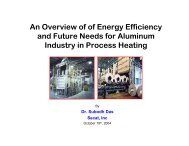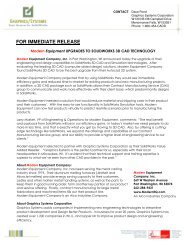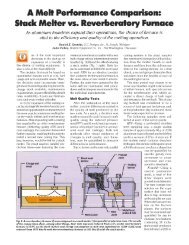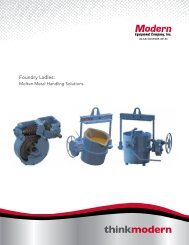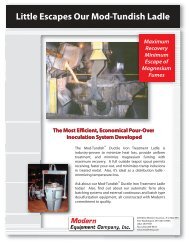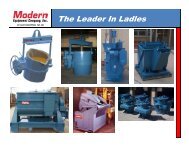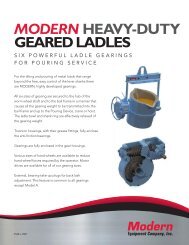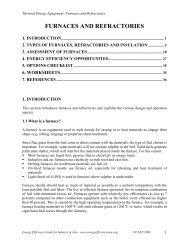ITP Metal Casting: Advanced Melting Technologies: Energy Saving ...
ITP Metal Casting: Advanced Melting Technologies: Energy Saving ...
ITP Metal Casting: Advanced Melting Technologies: Energy Saving ...
Create successful ePaper yourself
Turn your PDF publications into a flip-book with our unique Google optimized e-Paper software.
necessary to impart the mechanical properties the casting facility desires. Furthermore, the<br />
temperature requirements vary for each alloy/metal melted in the furnace. Therefore, the concept<br />
of a single melting technology that can crosscut the entire metal casting industry is unreasonable.<br />
Advances along multiple pathways are required that suit the needs of different casting facilities<br />
for achieving significant energy savings in the overall melting process.<br />
Batch-<strong>Melting</strong> Schedule<br />
The scheduling of melting is traditionally determined by the casting requirements of the metal<br />
casting facility. Most casting facilities melt in batches, in which case, the facilities tend to<br />
schedule to melt at certain hours of the day on certain days of the week. This practice requires<br />
frequent starting and idling of<br />
the melting equipment, thus reducing the efficiency of the<br />
operation. In addition, many metal casters produce variable-sized heats, which require the<br />
operation of several different-sized furnaces and involve heating many cold furnaces, a factor<br />
that further reduces the energy efficiency of melting. The inconsistent heat sizes also increase<br />
the<br />
maintenance cost because of the stress imposed on the furnace refractory from the significant<br />
swings in the temperature.<br />
Requirement of New Permits<br />
New furnace technologies, particularly those that require new or expanded exhaust systems,<br />
frequently require local and state permits. Obtaining these permits incur financial costs and<br />
require valuable personnel time.<br />
Many small metal casters find it difficult to allocate these<br />
resources for acquiring permits when<br />
implementing new technologies at their foundries.<br />
<strong>Advanced</strong> melting technologies that can be retrofitted onto the existing equipment without any<br />
need for new permits are, as a result, more likely to be adopted by the industry.<br />
6. Future Direction of Research: Potential <strong>Energy</strong>-<strong>Saving</strong><br />
<strong>Technologies</strong><br />
The following recommendations for R&D offer the most promising opportunities for decreasing<br />
energy consumption in melting operations in the metal casting industry.<br />
Retrofit <strong>Technologies</strong> Database<br />
Tool<br />
Considering the diversity of the U.S. metal casting operations and their limited resources,<br />
possibly the most advantageous path for introducing energy-efficient melting technologies is to<br />
develop a web-based database tool of available retrofit technologies. This tool will enable metal<br />
casters to compare and weigh their options when evaluating the new melting technologies. The<br />
casters must be able to input their furnace type, scheduling, alloy, and tonnage requirements. The<br />
tool could then output various retrofit technology options or a combination of options that can<br />
meet their production demands, along with pros and cons of each option. The tool should also<br />
provide rough estimates of the implementation cost and fine-tune the potential of each retrofit<br />
technology, along with the estimated energy and cost savings. Such a tool would assist the metal<br />
casting industry in making educated and nonbiased decisions on how to improve their foundries’<br />
36



